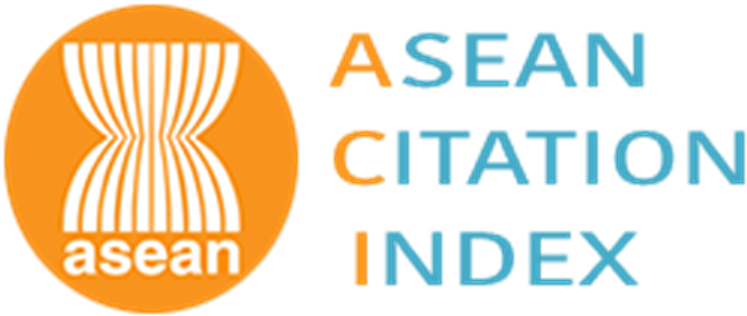การวิเคราะห์สัมประสิทธิ์น้ำท่า อัตราการไหลสูงสุด และพื้นที่น้ำท่วม ในลุ่มน้ำลำพระเพลิงด้วยแบบจำลอง MIKE FLOOD
Analysis of Runoff Coefficients, Peak Flows and Flood Maps in Lam Phra Phloeng River Basin Using MIKE FLOOD
Abstract
ในสภาวะที่ฝนตกหนักเป็นเวลานานทำให้เกิดน้ำท่วมครั้งใหญ่ในลุ่มน้ำลำพระเพลิงเช่นใน พ.ศ. 2553 และ พ.ศ. 2563 ซึ่งเกิดความเสียหายต่อเศรษฐกิจ และการอยู่อาศัยของประชากรในพื้นที่อย่างมาก การศึกษานี้จึงมีวัตถุประสงค์เพื่อ 1) วิเคราะห์หาค่าสัมประสิทธิ์น้ำท่า 2) วิเคราะห์ความสัมพันธ์ระหว่างอัตราการไหลสูงสุดและพื้นที่รับน้ำ และ 3) จัดทำแผนที่น้ำท่วมสูงสุดในลุ่มน้ำลำพระเพลิงด้วยแบบจำลอง MIKE FLOOD จากผลการศึกษาพบว่า ค่าสัมประสิทธิ์น้ำท่าเฉลี่ยทั้งลุ่มน้ำลำพระเพลิงมีค่าเท่ากับ 0.286 และความสัมพันธ์ระหว่างอัตราการไหลสูงสุด (QF) และพื้นที่รับน้ำ (A) คือ QF = 1.9099A0.7944
และความสัมพันธ์ระหว่างปริมาณน้ำท่ารายปีเฉลี่ย (Ravg) กับปริมาณน้ำฝนรายปีเฉลี่ย (Pavg) คือ Ravg = 0.0012 Pavg1.935 สำหรับพื้นที่น้ำท่วมสูงสุดมีพื้นที่ที่ได้รับความเสียหาย 19 ตำบล 3 อำเภอ โดยครอบคลุมพื้นที่ส่วนใหญ่ในอำเภอปักธงชัย และพื้นที่บางส่วนในอำเภอโชคชัยและอำเภอสูงเนิน ทั้งนี้ พื้นที่น้ำท่วมสูงสุดเท่ากับ 153.056 ตารางกิโลเมตร หรือคิดเป็นพื้นที่ร้อยละ 6.59 ของพื้นที่ลุ่มน้ำลำพระเพลิง เมื่อนำแผนที่น้ำท่วมที่ได้จากแบบจำลอง MIKE FLOOD มาตรวจสอบความน่าเชื่อถือด้วยวิธี Confusion Matrix กับภาพถ่ายดาวเทียมแสดงแผนที่น้ำท่วมของ GISTDA พบว่า มีความน่าเชื่อถือของแบบจำลองเท่ากับ 82.9 เปอร์เซ็นต์ นอกจากนี้แบบจำลอง MIKE FLOOD สามารถนำมาใช้จำลองแผนพื้นที่น้ำท่วมได้อย่างดีทั้งในช่วงเวลาที่มีภาพถ่ายดาวเทียม และไม่มีภาพถ่ายดาวเทียมแสดงแผนที่น้ำท่วมจาก GISTDA และสามารถนำผลการศึกษานี้ไปประยุกต์ใช้กับกรณีศึกษาพื้นที่อื่น ๆ ได้ต่อไป
Due to the long periods of torrential rains in 2010 and 2020, massive floods took place in the Lam Phra Phloeng river basin, causing negative impacts on economic growth and local community’s ways of living. The objectives of this study are 1) to determine the runoff coefficient, 2) to analyze the relationship between the maximum flow rate and the catchment area, and 3) to create the inundation map presenting probable maximum flood for the Lam Phra Phloeng river basin using the MIKE FLOOD modelling. As results, the average runoff coefficient of the entire region of Lam Phra Phloeng river basin was 0.286. The relationship between the maximum flow (QF) rate and the catchment area (A) was QF = 1.9099A0.7944 . The relationship between average annual runoff (Ravg) and average annual rainfall (Pavg) was Ravg = . The areas most affected by floods covered 19 sub-districts in 3 districts, ranging from Pak Thong Chai district with the highest flood risk and some locations in Chok Chai and Sung Noen districts. The greatest flood-hazard areas accounted for 153.056 square kilometers, representing 6.59% of total area in the Lam Phra Phloeng River Basin. Flood inundation modeling obtained from the MIKE FLOOD was explored for reliability using the confusion matrix with satellite images showing flood maps form GISTDA. The model's reliability proved to be 82.9 %. In addition, the MIKE FLOOD model could be effectively applied to simulate flood areas irrespective of GISTDA's satellite-derived flood images. The results of this single case study could be further applied to explore inundation scenarios in different areas.
Keywords
[1] GISTDA. (2020). Flooding Pak Thong Chai 2020. [Online]. Available: https://www.gistda.or.th/ news_view.php?n_id=2284&lang=TH
[2] P. Kosa, T. Sukwimolseree, P. Teekabunya, and T. Utansawat. (2022). Assessment of water transport potential in the Lam Phra Phloeng River using HEC RAS. [Online]. Available: https:// conference.thaince.org/index.php/ncce25/ article/view/601/338
[3] P. Bumrungklang, “integration of remote sensing and geographic information system for assigning risk areas in Lam Phra Phloeng Watershed,” M.S. thesis, Science (Remote Sensing). Suranaree University of Technology, Nakhonratchasima, 2010 (in Thai).
[4] R. Srivoramas, “Charact eristics and properties of stream runoff from watersheds in Northeeast Thailand,” M.S. Thesis, Department of Civil Engineering, Faculty of Engineering Khon Kaen University, 2000 (in Thai).
[5] R. Machada, “Determination of the runoff Coefficient (C) in catchments based on analysis of precipitation and flow events,” University of Campinas, 2019.
[6] J. Son and T. Kwon, “Evaluation and improvement measures of the runoff coefficient of urban parks for sustainable water balance,” Land, vol. 11, no. 7, pp. 1098, 2022.
[7] N. Sriwongsitanon and W. Taesombat. “Effects of land cover on runoff coefficient,” Journal of Hydrology, vol. 410, pp. 226–238, 2011.
[8] J. Galster, “Testing the linear relationship between peak annual river discharge and drainage area using long-term USGS river gauging record,” Montclair State University May, 2009.
[9] M. İ. Yüce, M. Eşit and B. Ercan, “A relationship between Flow Discharge, Sediment Discharge and Sub-Basin Areas in Ceyhan Catchmen,” presented at 13th International Congress on Advances in Civil Engineering, September, 2018.
[10] P. Kosa, Integration of GIS with HEC RAS Model for Water Management in Large Areas. Agricultural Research Development Agency (ARDA), 2019 (in Thai).
[11] P. Bumrungklang and P. Kosa, “Flooding Simulation using MIKE FLOOD Model A case study: Lam Taklong River Basin,” Technical Education Journal King Mongkut’s University of Technology North Bangkok, vol 8, no. 2, pp. 182–193, 2017 (in Thai).
[12] MIKE 11 Reference and User Manual, Danish Hydraulic Institute (DHI)., Horsholm, Denmark, 2011.
[13] MIKE 21 Reference and User Manual, Danish Hydraulic Institute (DHI)., Horsholm, Denmark, 2012.
[14] MIKE FLOOD Reference and User Manual, Danish Hydraulic Institute (DHI)., Horsholm, Denmark, 2021.
[15] P. Bumrungklang, “Flood inundation mapping by using mike flood model : A case study at lam taklong river basin,” M.S. Thesis, Department of Civil Enginnering, Faculty of Enginnering, Suranaree University of Technology, Nakhonratchasima, 2015 (in Thai).
[16] Royal Irrigation Department. The Study of Runoff Coefficient and Relation between Mean Annual Runoff of 25 River Basin in Thailand, 2009 (in Thai).
[17] W. Mingmuang and J. Kanasut, “Decision Support System of Flood Management (Cast Study: Nakhon Ratchasima),” M.S. Thesis, Department of Water Resources Engineering, Faculty of Engineering, Khon Kaen University, 2013 (in Thai).
[18] Thai PBS. (2020). Pak Thong Chai flooded heavily, affecting 5,000 household. [Online]. Available: https://www.thaipbs.or.th/news/ content/297597
[19] Disaster Victim Relief Division. (2023). Statistics of government advances spending 2003 – present. [Online]. Available: http://view.officeapps.live. com/op/view.aspx?src=http%3A%2F%2Fassist.disaster.go.th%2Fsite4%2Fdownload-src.php% 3Fdid%3D45881&wdOrigin=BROWSELINK
DOI: 10.14416/j.kmutnb.2024.08.003
ISSN: 2985-2145





